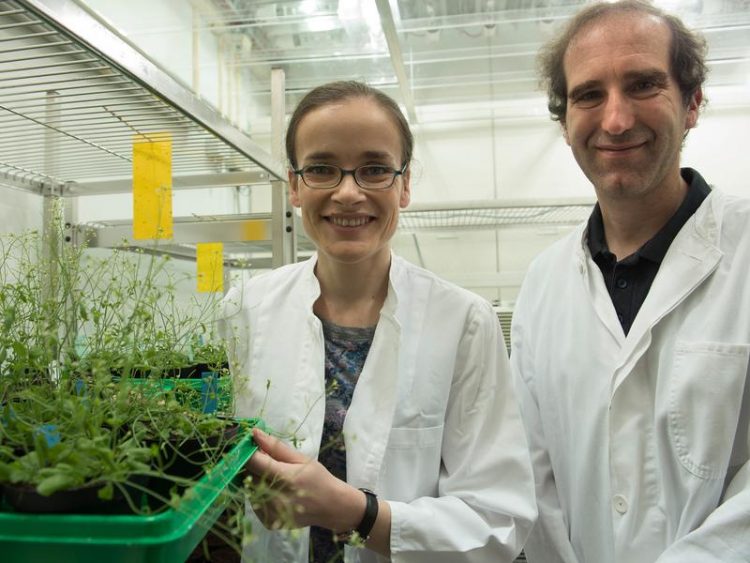Helpers for energy acquisition from plants

Investigated the chloroplasts of Arabidopsis thaliana: Barbara Kalisch and Prof. Peter Dörmann of the Institute of Molecular Physiology and Biotechnology of Plants at Universität Bonn. © Photo: Barbara Frommann / University of Bonn
The study makes reference to the endosymbiotic theory, which was put forward back in 1883 by the Bonn university scholar Andreas Franz Wilhelm Schimper and has long been viewed as proven.
According to the theory, at least a billion years ago, a photosynthetic bacterium must have penetrated a plant host cell, where it developed into a chloroplast. Without this so-called “endosymbiosis”, photosynthesis, which is the process by which light energy converts carbon dioxide and water into sugar and oxygen, would not be possible in plants.
This former bacterium inside the host cell is surrounded by two membranes. The predominant components of these membranes are the so-called galactolipids. These two envelope membranes were the focus of attention of the scientists during their years of investigation.
“The question that our research sought to answer was exactly what each membrane is responsible for”, explains Professor Peter Dörmann, Director of the Institute of Molecular Physiology and Biotechnology of Plants at Universität Bonn.
Scientists experiment with plant mutants
For this purpose, the scientists experimented with mutants of the often-used research plant thale cress (Arabidopsis thaliana). They modified the mutant plant by adding various genetically manipulated variants of a protein of the galactolipid production system, which is located on the outer membrane of the chloroplast. The most important finding: This protein is essential for the embedding of the former bacterium in the cell.
“Without the protein, the chloroplast cannot survive. Without the chloroplast, the plant cannot survive”, says Barbara Kalisch, doctoral researcher at Universität Bonn, who was one of the lead authors for the now published article.
“Lipids cannot simply move through water”
In addition to the production of the galactolipids, the protein is also involved in the transfer of galactolipids from the outer to the inner of the two envelope membranes. In their experiments, the researchers also placed the protein artificially on the inner membrane. Lipid production worked there, too; the plant remained able to survive. When the protein is on the inner envelope membrane, no further transport is necessary. Why the location in nature is on the outside and not the inside, has not yet been clarified.
The experiments also indicate that the protein is the reason that there can be any lipid exchange at all between the two envelope membranes of the chloroplasts. That is important, so that the chloroplast, and with it the plant, can grow. The space between the two envelope membranes is filled with water, but “lipids cannot simply move through water”, explains Prof. Peter Dörmann of Universität Bonn. However, other factors can affect this lipid exchange. “Our investigations to date certainly do not represent the end of our research”, says Dörmann.
Publication: Amélie A. Kelly, Barbara Kalisch, Georg Hölzl, Sandra Schulze, Juliane Thiele, Michael Melzer, Rebecca L. Roston, Christoph Benning, and Peter Dörmann: Synthesis and transfer of galactolipids in the chloroplast envelope membranes of Arabidopsis thaliana, “Proceedings of the National Academy of Sciences of the USA”, DOI: 10.1073/pnas.1609184113
Contact for the media:
Prof. Peter Dörmann
Institute of Molecular Physiology and
Biotechnology of Plants
Universität Bonn
Tel.: +49-228 73-2830
E-Mail: doermann@uni-bonn.de
Media Contact
More Information:
http://www.uni-bonn.de/All latest news from the category: Life Sciences and Chemistry
Articles and reports from the Life Sciences and chemistry area deal with applied and basic research into modern biology, chemistry and human medicine.
Valuable information can be found on a range of life sciences fields including bacteriology, biochemistry, bionics, bioinformatics, biophysics, biotechnology, genetics, geobotany, human biology, marine biology, microbiology, molecular biology, cellular biology, zoology, bioinorganic chemistry, microchemistry and environmental chemistry.
Newest articles

Properties of new materials for microchips
… can now be measured well. Reseachers of Delft University of Technology demonstrated measuring performance properties of ultrathin silicon membranes. Making ever smaller and more powerful chips requires new ultrathin…

Floating solar’s potential
… to support sustainable development by addressing climate, water, and energy goals holistically. A new study published this week in Nature Energy raises the potential for floating solar photovoltaics (FPV)…

Skyrmions move at record speeds
… a step towards the computing of the future. An international research team led by scientists from the CNRS1 has discovered that the magnetic nanobubbles2 known as skyrmions can be…





















